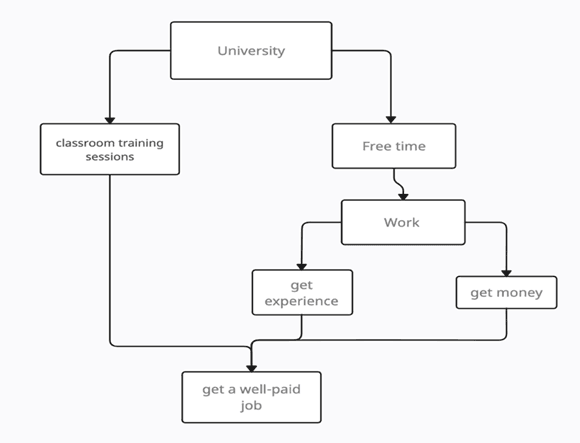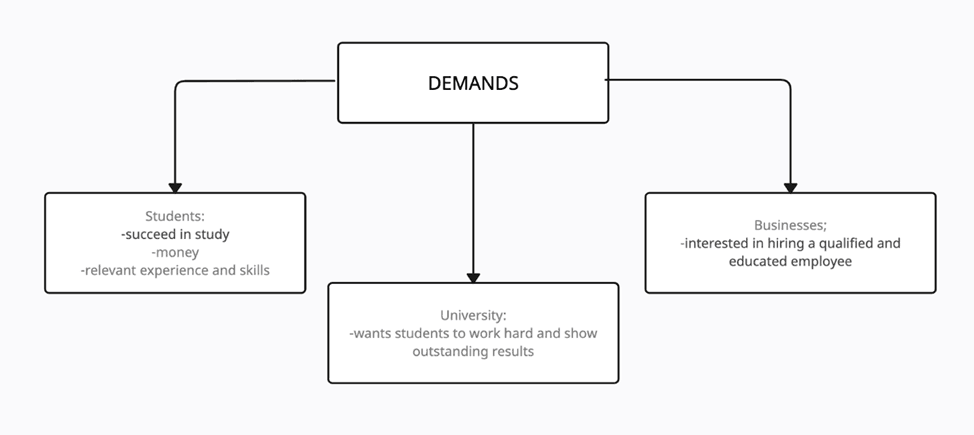Introduction
The dream of every child in his or her childhood was a rich and carefree life in the future. Probably, the ideal option for each would be not to work at all but to have an enormous amount of money regularly, what is, of course, a true fairy tale in our world. So, the question is how a person may succeed in getting a highly paid job that would bring him not only good salary, but also a personal satisfaction from process.
The answer lies in our childhood and adolescence. A big and vital step in our life that captures both of these periods is school. Most schools in our country have a certain system and its own rules and regulations, which students are taught to follow from the first grade [1, p. 51]. Therefore, the slightest violation of discipline or deviation from the norms will be punished. On the one hand, such approach trains discipline, but on the other hand, teenagers do nothing but try to adjust to this strict system and not break the rules. It becomes obvious that in such atmosphere it is hardly possible for a typical youngster to accurately determine a future profession that is more likely to appeal to him.
Well, having passed the Unified State Exam, young adults in Russia go to universities. Within four or five years he or she studies for the chosen profile and specialization that would probably be his or her future job. Thus, it is of vital importance for them to burn the midnight oil and pass exams with flying colors, because any employer searches for a well-educated and smart employee. But the question is: “Is it really possible for a typical student to become sufficiently aware of their future profession without practice?” Of course, the answer is “No”. And, probably, the only right solution to this disputable problem is working while studying. So that, a problem is brewing: how can a young man be torn between two important aspects of his life: study and work and therefore, another serious question arises: will a young man be able to combine practice and university and what difficulties he or she may face?
Problem and key aspects
Over the past decade, both, the education sector, and the labor market have undergone tremendous changes and due to that, both areas tend to adapt to the challenges of the economy, political and social transformations [2, p. 24]. It is a well-known fact that universities are suppliers of qualified workforce for the socio-economic development of the country, however, at this stage the process of interaction between educational institutions and the labor market is complex and ambiguous. According to the laws on education (as an example we can take Federal Law "On Education in the Russian Federation" [3, p. 10]), university students are required to acquire knowledge and complete all types of tasks provided for in the Institute's curriculum within the prescribed time frame. Nevertheless, most students spend their time outside of classroom training sessions devoted to self-study on paid work [4]. A clear correlation is emerging that can be represented in the form of a scheme.

Fig. 1. Correlation between full-time study and work
Let us find out what is the real connection between study and work. According to the table, by spending free from lessons time on paid work, students solve both: their pressing problems (financial) and the predicted ones (acquisition of special skills). Therefore, combining work and classroom training sessions, students pursue one goal: to get a highly-paid and prestigious job of their dreams.
This leads us to the next issue we need to consider. First, if a student decides to have a practice, the amount of effort required for their studies will increase and their grades may not be excellent. This is because perfect attendance is necessary, and professors are unwilling to make exceptions by putting themselves in somebody’s shoes.
Consequently, when it comes for young adults to apply for a job, they are more likely to choose a café or a position of a sales assistant due to a flexible schedule and reasonable salary. According to the statistics revealed by the hh.ru and by the HSE Institute, 38% of students work in their specialty during their studies, the remaining 68% hold positions unrelated to their future profession [5, p. 44].
Solution
In order to find appropriate solution, we have to think over the demands of students, businesses and universities and find the relation between them.

Fig. 2. Demands of each participant of the process
It is better to start with the businesses. Any employer is interested in hiring a qualified and educated employee who does not require too much time for training and introduction to the specialty, but on the contrary, is immediately ready to start performing duties. Only universities that aim to provide high-quality education to students and want them to study hard can close such a need for professional workers [6].
The third demand are students, who, in turn, are concerned both about doing well in studies while getting relevant experience and skills for a future position and earning their own money to feel the sense of full freedom.
The arguments presented above suggest the only correct solution to this problem: to build a cooperation between universities and businesses.

Fig. 3. The right solution
Theoretical training without real practice is not very effective, so it is worth paying attention to the possibility of developing relations between industries and institutions of higher education. Furthermore, business organizations can take the opportunity to partner with universities and colleges to provide students with real-world, tangible workforce experience to prepare them for life outside their education.
One way in which this collaboration can improve career and employment opportunities is through internships and work placements. Universities often partner with businesses to offer students practical work experience in a real-world setting. This allows students to apply their theoretical knowledge in a professional setting, gaining valuable skills and experience that can enhance their employability upon graduation.
Additionally, close and active cooperation between businesses and universities can lead to the development of specialized training programs and courses tailored to the needs of industry. This can help students acquire the skills and knowledge that are in high demand in the workforce, making them more attractive to potential employers. By aligning curricula with industry needs, universities can produce graduates who are better prepared to meet the challenges of the modern workplace.
Conclusion
Summarizing all the arguments mentioned above, we are coming to a logical and obvious conclusion: The sooner you start practicing, the better it will be for you and your future career and regardless of the company you choose to work for, it is of vital importance that your first job aligns with your specialty. This initial experience will set you on the path towards pursuing your dream career, and the more proactive and engaged you are, the sooner your aspirations will be realized.

.png&w=640&q=75)